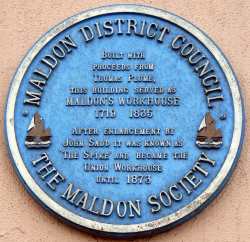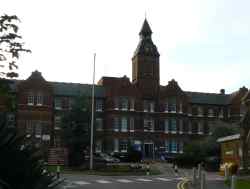Maldon Union Workhouse
|
In 1601
the first poor law was passed with the become that materials
should be bought to provide work for the able bodies and
that housing should be built for those unable to care for
themselves.
Ammendations to the Poor law were
passed from time to time although there seemed to be a
general acceptance amongst parishes that there should be
some provision for the poor and incapable. In most Parishes
accommodations was provided although some Parishes provided
financial assistance for people to be housed elsewhere
In 1777 Parliament commissioned a
survey of poor relief which showed that Workhouses had been
established in the Parishes of Burnham, Purleigh,
Southminster, Steeple, Stow Maries and Tillingham. Bradwell
on Sea, and Latchingdon also had workhouses but these
appeared to have opened after 1777.
Bannister Cottage is believed to
be the location of the workhouse in Woodham Walter that was
in operation about 1809.
Blue House in Waterside Road was
the location of the Bradwell on Sea workhouse.
The old Queens Head Public House
was the workhouse at Purleigh.
Until it closed in 1860,
Southminster Poor House stood on a site that is now used by
the Primary School.
In some cases these workhouses
were comparatively substantial with the Burnham workhouse
offering 24 places whereas Steeple offered just 6 places.
The larger workhouses would have an overseer although some
of the smaller would have a local person with
responsibilities including supervision of the inmates.
All able bodied inmates including
children would be expected to carry out work in exchange for
accommodation and board with any takings being set against
the expense of maintaining the workhouse.
In 1831 the Government conducted a
thorough review of Workhouses which gives us a picture of
our area.
The costs against population are
interesting.
Some like Creeksea allocate only
about 40 pence per person whilst others like nearby
Asheldham allocate over £2 per person.
The costs related to the number of
people in care, cost of medication etc.
In 1831 the sums of money involved
to support the poor were considerable to a generally poor
population.
In 1834 The Poor Law Amendment Act
was passed which required Parishes to group together and
provide a workhouse. To deter people from taking advantage
of the ' generosity a deliberately harsh regime was
encouraged with the provision of basic accommodation and a
basic diet large enough to sustain life of the inmates.
In this
area the Maldon Union Workhouse was formed to represent all
of the parishes in the District. Initially the existing
Maldon workhouse on Market Hill was extended and used for
able bodies men whilst the aged, ill ,women and children
were houses at the three other larger parish workhouses
including Purleigh and Burnham on Crouch .The remaining
parish workhouses were returned to private ownership.
Even after 1834 support to the
poor in Parishes continued often due to local benefactors.
An example of this was Wm. Ayletts of Althorne who
established a charity fund for the poor that in 1863 gave
£1.18 shillings to the poor which for the time was a
considerable sum.
In 1861 the Government surveyed
workhouses for the number of paupers who had resided there
for five years or more.
In the case of Maldon there were
26 such paupers, 4 of which had lived for over 20 years at
the workhouse and half had lived for over 10 years.
The causes of this prolonged stay
were given as :-
Infirmity 12 paupers - Lameness 3
Paupers - Paralysis 1 pauper - Sickness 3 paupers -
Illegitimate children 2 paupers - Blindness 2 paupers -
Unsound mind 2 paupers - Idiotcy 1 pauper.
The existing buildings provided
much to small to deal and in 1872/1873 a new and very
distinctive workhouse was built in Spital Road, Maldon. This
building subsequently became St Peters Hospital at the birth
of the national Health Service.
|
||||||||||||||||||||||||||||||||||||||||||||||||||||||||||||||||||||||||||||||||||||||||||||
The
1881 census provides details of the 114 occupants of the new
Workhouse. Residents with birthplaces in the Dengie Hundred are listed
below
|
Name |
Approx Date of Birth |
Place of Birth |
|
Henry Alefounder |
1806 |
Burnham on Crouch |
|
William Blowers |
1805 |
St Lawrence |
|
Joseph Braizer |
1821 |
Stow Maries |
|
Owen Brand |
1813 |
Purleigh |
|
Jno Bridge |
1799 |
Southminster |
|
James Brown |
1807 |
Woodham Walter |
|
Jno Cable |
1808 |
Southminster |
|
Sarah Carter |
1815 |
St Lawrence |
|
Emma Challis |
1875 |
Mundon |
|
William Choat |
1813 |
Burnham on Crouch |
|
James Collins |
1815 |
Steeple |
|
William Cottis |
1816 |
Tillingham |
|
Edith Duce |
1860 |
Steeple |
|
Infant Duce |
1881 |
Maldon |
|
James Duce |
1808 |
Asheldham |
|
Thomas Enifer |
1813 |
Stow Maries |
|
Isaac Filbrook |
1817 |
Woodham Walter |
|
Thomas Fisher |
1804 |
Tillingham |
|
William Fulcher |
1816 |
Latchingdon |
|
Genery Gladwell |
1838 |
Bradwell on Sea |
|
Henry Harrison |
1806 |
Steeple |
|
Alice Harvey |
1858 |
Southminster |
|
Infant Harvey |
1881 |
Burnham on Crouch |
|
Joseph Hoy |
1801 |
Althorne |
|
Henry Hubbard |
1853 |
Tillingham |
|
Jno Jennings |
1807 |
Althorne |
|
Mary Jennings |
1867 |
Cold Norton |
|
James Joslin |
1840 |
Woodham Walter |
|
William Lamb |
1808 |
Dengie |
|
George Leggett |
1818 |
Steeple |
|
James Lilley |
1825 |
Bradwell on Sea |
|
Susan Lincoln |
1820 |
Purleigh |
|
William Linge |
1808 |
Mayland |
|
Alfred Marshall |
1869 |
St Lawrence |
|
Maria Millham |
1831 |
Burnham on Crouch |
|
William Millham |
1801 |
Burnham on Crouch |
|
Jesse Milton |
1815 |
Southminster |
|
George Murrell |
1833 |
Burnham on Crouch |
|
James Pinner |
1809 |
Bradwell on Sea |
|
Thomas Prior |
1804 |
Mundon |
|
George Rayner |
1796 |
Latchingdon |
|
Joseph Richmond |
1812 |
Burnham on Crouch |
|
James Saines |
1809 |
Burnham on Crouch |
|
William Seaby |
1805 |
Purleigh |
|
William Sparks |
1817 |
Southminster |
|
Philip Tiffin |
1812 |
Mayland |
|
Jno Willingale |
1850 |
Southminster |
Click Here to visit a page listing the officials of the
Maldon Union from 1846 to 1869
Click here to visit a page listing the Guardians of the
Maldon Union in 1911
Click here to visit a page listing items from the
records of Maldon Workhouse 1895-1930
Click
here to visit a page describing the history of the Poor
Laws and highlighting the case of Jane Harris






